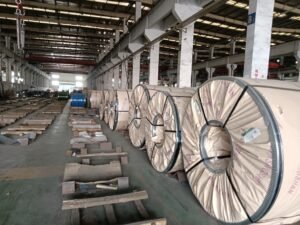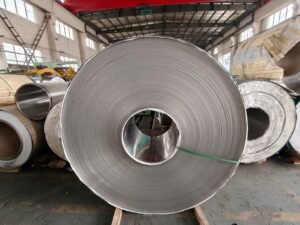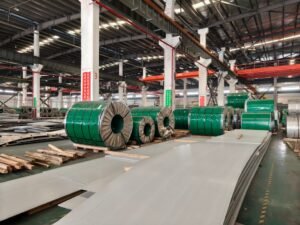Introduction
Choosing the right material for your project can make or break its success. When it comes to Carbon Steel vs. Stainless Steel, engineers and factory managers often grapple with balancing strength, corrosion resistance, and budget constraints. The wrong choice could lead to costly failures or maintenance headaches.
That’s why understanding their core differences—from composition to cost and application—is critical. At HnL Steel, we’ve seen firsthand how these materials perform across industries. This guide breaks down their properties, pricing trends, and real-world uses to help you pick the best steel for your needs.
Defining Carbon Steel and Stainless Steel: Core Concepts
When it comes to building strong structures or crafting durable tools, choosing between Carbon Steel vs. Stainless Steel can make or break a project. These two materials are superstars in the industrial world, but they have unique traits that suit different needs. Let’s break it down by defining what each is and why picking the right one matters.
Hey, when you’re stuck deciding, it’s like picking your ride-or-die buddy for a tough task—each has its strengths! So, let’s dive into the basics of these materials. This will help engineers and builders make smart choices for their work.
What is Carbon Steel? Iron-Carbon Composition and Key Characteristics
Carbon steel is a mix of iron and carbon, with the carbon content usually between 0.05% and 2.1%. This blend gives it strength and toughness, making it a go-to for construction beams and tools. However, carbon steel properties also mean it can rust easily if not coated or treated.
It’s often cheaper than other options, which is why it’s popular for big projects. Think of bridges or pipelines—these often rely on carbon steel’s durability. But you’ve got to keep an eye on corrosion if it’s exposed to moisture.
What is Stainless Steel? Role of Chromium in Enhancing Properties
Stainless steel, on the other hand, is an alloy of iron, carbon, and at least 10.5% chromium. This chromium creates a protective layer that fights rust, giving stainless steel benefits like corrosion resistance. That’s why it shines in kitchens, medical tools, and outdoor structures.
It’s a bit pricier, but its long life often makes up for the cost. Plus, it’s recyclable, which ties into the growing focus on sustainability. More industries are choosing it to reduce waste and environmental impact.
Why Material Selection Matters for Engineering and Industrial Projects
Picking between Carbon Steel vs. Stainless Steel isn’t just a guess—it’s a critical decision. Using the wrong material can lead to failures, higher costs, or safety risks. For example, carbon steel might crack under wet conditions, while stainless steel could be overkill for a simple indoor frame.
That’s where expert guidance comes in handy. At HnL Steel, we’ve spent over 10 years helping engineers and managers navigate the differences between carbon steel and stainless steel. Our tailored advice ensures your project gets the perfect fit for performance and budget.
Brief Overview of Metallurgical Properties Impacting Performance
Both materials have unique metallurgical traits that affect how they perform. Carbon steel’s hardness depends on its carbon level—higher carbon means more strength but less flexibility. Stainless steel’s chromium content boosts its resistance to wear and tear over time.
Choosing between carbon steel and stainless steel can impact a project’s durability and cost, so understanding their core properties is key to smart decision-making.
These traits influence everything from weight to heat resistance. Knowing them helps predict how a material will hold up under stress. It’s all about matching the metal to the job.
Comparison of Carbon Steel and Stainless Steel Properties
| Property | Carbon Steel (Low Carbon) | Carbon Steel (High Carbon) | Stainless Steel (304 Grade) | Industry Benchmark |
|---|---|---|---|---|
| Tensile Strength (MPa) | 400-550 | 600-800 | 515-620 | 500-700 |
| Corrosion Resistance | Low (Rust-Prone) | Low (Rust-Prone) | High (Chromium Layer) | Moderate to High |
| Cost per Ton (USD Approx.) | 500-700 | 600-800 | 2000-2500 | 1000-2000 |
| Ductility (% Elongation) | 20-30% | 10-15% | 40-50% | 25-40% |
| Recyclability | High | High | Very High | High |
Note: Tensile strength is measured via stress tests per ASTM standards; corrosion resistance reflects typical environmental exposure; cost varies by market trends (data based on 2023 estimates); ductility shows flexibility before breaking; recyclability aligns with sustainability goals.
Composition and Performance: Breaking Down Material Differences
When deciding between Carbon Steel vs. Stainless Steel, understanding their makeup is the first step. These materials might look similar, but their chemical compositions create big differences in how they perform. Let’s dig into what they’re made of and how that impacts strength and durability for various projects.
Think of it like choosing the right ingredients for a recipe. The mix matters! Whether you’re wondering which steel is better for building projects, this steel material comparison will help clarify things.
Carbon Steel Composition: Iron, Carbon, and Trace Elements
Carbon steel is mostly iron with a small amount of carbon—usually between 0.05% and 2.1%. This carbon boosts its strength, but other tiny elements like manganese or silicon can be added to tweak its toughness. Too much carbon, though, can make it brittle and hard to shape.
This simple mix makes carbon steel affordable and strong for things like bridges or car parts. But without protection, it can rust when exposed to water or air. That’s a key factor to consider for outdoor use.
Stainless Steel Composition: Chromium, Nickel, and Alloy Variants
Stainless steel starts with iron and carbon but adds at least 10.5% chromium for rust resistance. Many types also include nickel or molybdenum to improve flexibility and fight corrosion even more. Different blends create grades suited for specific jobs, like kitchen tools or chemical tanks.
Thanks to its makeup, stainless steel often lasts longer and supports sustainability with high recyclability. It’s a top pick when you need something to withstand harsh conditions. That durability comes at a higher price, though.
Impact on Tensile Strength, Hardness, and Flexibility
The metallurgical properties of these steels shape how they hold up under stress. Carbon steel’s strength grows with more carbon, but it can snap if bent too much. Stainless steel, with its added elements, often bends better and resists wear over time.
These traits affect what each steel can handle. High-carbon steel is great for cutting tools due to hardness, while stainless steel’s flexibility suits structures that need to give a little. Matching these qualities to your project is crucial.
How Composition Drives Performance in Industrial Applications
Choosing between Carbon Steel vs. Stainless Steel boils down to the job at hand. Carbon steel shines in heavy, cost-sensitive builds like pipelines, while stainless steel is ideal for wet or corrosive environments like marine equipment. Getting this right prevents failures and saves money.
At HnL Steel, we offer a wide range of products and customized solutions to match specific composition needs. Our team supports engineers in aligning material properties with project demands, ensuring the best fit for performance and budget.
“Understanding the chemical makeup of carbon steel and stainless steel helps builders pick the right material for strength and durability in any project.”
Composition and Performance Data Comparison
| Property | Carbon Steel (Low Carbon) | Carbon Steel (High Carbon) | Stainless Steel (316 Grade) | Typical Use Case |
|---|---|---|---|---|
| Carbon Content (%) | 0.05-0.3 | 0.6-2.1 | 0.08 Max | Varies by Strength Need |
| Chromium Content (%) | 0 | 0 | 16-18 | Corrosion Resistance |
| Tensile Strength (MPa) | 400-550 | 600-800 | 515-690 | Structural Integrity |
| Hardness (Brinell) | 120-150 | 200-300 | 150-200 | Wear Resistance |
| Corrosion Resistance | Low | Low | Very High | Environmental Exposure |
Note: Carbon content defines strength levels (tested per ASTM); chromium enhances rust protection; tensile strength measures load capacity; hardness reflects durability via Brinell scale; corrosion resistance is assessed under typical conditions.
Corrosion Resistance and Maintenance: Which Steel Stands Up to the Elements?
When comparing Carbon Steel vs. Stainless Steel, one big question pops up: which handles tough weather and rough conditions better? Corrosion, or rust, can ruin materials over time, so knowing how these steels resist it is key for long-lasting projects. Let’s break down how each holds up and what it takes to keep them in good shape.
Whether you’re building in a rainy area or a dry zone, this info can save you headaches. It’s all about picking the right steel for your spot. Let’s dive into this steel corrosion resistance showdown!
Carbon Steel’s Vulnerability to Rust and Required Protective Coatings
Carbon steel is tough, but it’s no match for water or humid air without help. Its iron content reacts with oxygen and moisture, forming rust that weakens it over time. To fight this, it often needs coatings like paint or galvanization to block out the elements.
These protective layers add extra steps and costs to a project. If the coating wears off, rust creeps back in fast. So, carbon steel works best when you can keep up with maintenance.
Stainless Steel’s Superior Corrosion Resistance Due to Chromium Content
Stainless steel is a champ when it comes to fighting rust. Thanks to its chromium content—at least 10.5%—it forms a thin, invisible layer that shields it from corrosion. This makes it a top pick for wet or harsh settings.
Even better, this protection doesn’t need much upkeep. It’s why stainless steel often outlasts other options in tough spots. Plus, its recyclability ties into sustainability, a growing focus for many industries.
Maintenance Costs and Efforts: Long-Term Durability Comparison
Maintenance is a huge factor in choosing between Carbon Steel vs. Stainless Steel. Carbon steel demands regular checks, repainting, or re-coating to stop rust, which adds up in time and money. Stainless steel, though, usually just needs a quick clean to stay in top shape.
Over years, stainless steel often proves cheaper despite its higher upfront cost. It’s built to last with less hassle. That durability makes a difference for big projects with tight budgets.
Best Environments for Each Material (Wet, Chemical, Marine vs. Dry Settings)
Where you’re building matters a lot for applications of carbon steel vs stainless steel. Carbon steel fits well in dry, indoor settings or places where coatings can be maintained, like warehouses. But in wet, chemical, or marine areas, it struggles without constant care.
Stainless steel thrives in those harsh spots—think shipyards or coastal builds. At HnL Steel, we offer corrosion-resistant stainless steel options and protective coatings for carbon steel, ensuring long-term value for factory managers in tough industrial settings.
“Stainless steel’s natural rust resistance makes it a smart choice for harsh environments, while carbon steel needs extra protection to last in the same conditions.”
Corrosion Resistance and Maintenance Comparison
| Factor | Carbon Steel (Low Carbon) | Carbon Steel (Coated) | Stainless Steel (304 Grade) | Industry Standard |
|---|---|---|---|---|
| Corrosion Resistance (Rating) | Low (1/5) | Moderate (3/5) | High (5/5) | Moderate to High (4/5) |
| Maintenance Frequency (Per Year) | 2-4 Times | 1-2 Times | 0-1 Time | 1-2 Times |
| Maintenance Cost (USD/Ton Approx.) | 50-100 | 30-70 | 10-20 | 20-50 |
| Suitable Environment | Dry/Indoor | Moderate Humidity | Wet/Marine/Chemical | Varies by Material |
| Lifespan in Harsh Conditions (Years) | 5-10 | 10-15 | 20-30 | 15-25 |
Note: Corrosion resistance is rated on a 1-5 scale based on exposure tests; maintenance frequency reflects typical industrial upkeep; costs are 2023 estimates per ton for treatments; lifespan is assessed under wet or chemical conditions; suitability aligns with environmental exposure.
Cost Analysis: Balancing Upfront Expenses with Long-Term Value
Deciding between Carbon Steel vs. Stainless Steel often comes down to dollars and cents. While both materials have their strengths, their price tags and upkeep costs can sway a budget-conscious decision. Let’s break down the costs to help procurement managers pick wisely.
Think of it as a money match-up. You’ve got upfront spending and long-term savings to weigh. This look at the differences between carbon steel and stainless steel will clear things up for your next project.
Upfront Costs: Why Carbon Steel is Often More Affordable
Carbon steel usually wins on initial price. Its simple makeup—mostly iron and a bit of carbon—keeps production costs low, often ranging from $500 to $800 per ton based on 2023 estimates. That’s a big draw for large-scale builds where budget is tight.
Thanks to its carbon steel properties like strength, it’s a go-to for basic structures. But remember, this low cost doesn’t include extras like rust-proofing. That can bump up the bill later if not planned for.
Long-Term Value: Stainless Steel’s Durability and Low Maintenance Benefits
Stainless steel costs more upfront—think $2,000 to $2,500 per ton—but it often pays off over time. Its chromium content fights rust, meaning less repair or replacement down the road. Plus, its recyclability ties into sustainability goals many companies now prioritize.
You’re saving on maintenance since it doesn’t need constant coatings or treatments. For projects needing durability, this can mean fewer headaches. It’s a solid pick when longevity matters most.
Global Steel Pricing Trends and Supply Chain Considerations
Steel prices fluctuate based on global demand, raw material availability, and shipping costs. Carbon steel often sees sharper price swings due to market changes, while stainless steel holds steadier because of its alloy components. Supply chain delays can also hit budgets hard if not planned for.
Keeping an eye on trends helps with timing bulk buys. A good supplier can make a difference here. Knowing when to order can save a bundle on either material.
Budgeting for Bulk Orders in Construction and Manufacturing Projects
For big projects, bulk orders of Carbon Steel vs. Stainless Steel need careful cost planning. Carbon steel might cut initial spending, but factor in ongoing rust protection. Stainless steel’s higher start-up cost balances out with less upkeep over years.
At HnL Steel, we offer competitive pricing for bulk carbon steel orders and premium stainless steel products. Our flexible payment terms support procurement planning, ensuring cost efficiency for construction and manufacturing needs.
“Balancing upfront costs with long-term savings is crucial when choosing between carbon steel and stainless steel for budget-driven projects.”
Cost Comparison of Carbon Steel and Stainless Steel
| Cost Factor | Carbon Steel (Low Grade) | Carbon Steel (High Grade) | Stainless Steel (304 Grade) | Industry Average |
|---|---|---|---|---|
| Initial Cost (USD/Ton, 2023 Est.) | 500-600 | 600-800 | 2000-2500 | 1000-1500 |
| Maintenance Cost (USD/Ton/Year) | 50-100 | 40-80 | 10-20 | 30-60 |
| Lifespan (Years, Harsh Conditions) | 5-10 | 8-12 | 20-30 | 10-20 |
| Recyclability (% Recoverable) | 90% | 90% | 95% | 92% |
| Supply Chain Volatility (Rating) | High (4/5) | High (4/5) | Medium (3/5) | Medium-High (3.5/5) |
Note: Initial costs are based on 2023 global market estimates; maintenance reflects annual protective treatments; lifespan is tested under wet conditions; recyclability follows industry standards; volatility rating (1-5) indicates price fluctuation risk based on supply chain data.

Applications and Decision-Making: Choosing the Right Steel for Your Project
When it comes to picking between Carbon Steel vs. Stainless Steel, knowing where each shines can guide you to the best choice. These materials fit different jobs based on their strengths, and real-world examples can show you how they perform. Let’s explore their uses and how to decide what’s right for your needs.
Think of it as matching the perfect tool to a task. Whether it’s a huge building or a small gadget, this breakdown of applications of carbon steel vs stainless steel will help. You’ll be ready to make smart picks for any project.
Carbon Steel Applications: Construction, Heavy Machinery, and Structural Uses
Carbon steel is a favorite for big, tough jobs like construction and heavy machinery. Its strength makes it ideal for beams, bridges, and tools that need to handle serious weight. It’s often used in structural frames because it’s strong and budget-friendly.
You’ll see it in skyscrapers and factories where durability matters. But keep in mind, it needs protection from rust in wet areas. That’s a key factor for industrial applications of steel outdoors.
Stainless Steel Applications: Food Processing, Marine, and Chemical Industries
Stainless steel excels in places where rust can’t be an option. Thanks to its stainless steel benefits like corrosion resistance, it’s perfect for food processing equipment, marine structures, and chemical plants. Think of kitchen gear or boat parts—it keeps things safe and clean.
Its ability to withstand harsh conditions makes it a top choice. Plus, its long life and recyclability support eco-friendly goals. It’s a win for industries focused on sustainability.
Case Studies: Real-World Examples of Material Performance
Seeing Carbon Steel vs. Stainless Steel in action helps clarify their roles. For instance, carbon steel was used in the frames of the Burj Khalifa for its strength, but needed coatings to fight humidity. Meanwhile, stainless steel lines the equipment in dairy plants, resisting corrosion from constant cleaning.
These examples show how environment shapes material choice. Carbon steel fits dry, heavy builds, while stainless steel handles wet, harsh settings. Real cases like these guide better planning.
Decision Framework: Factors Like Environment, Budget, and Sustainability
Choosing the right steel means weighing a few big factors. Consider the environment—wet or dry?—then look at budget for upfront and upkeep costs, and don’t forget sustainability goals. A clear plan helps match the material to your project’s needs.
At HnL Steel, we’re a trusted partner for industry-specific solutions, offering personalized recommendations and fast delivery for carbon or stainless steel projects. We also highlight stainless steel’s sustainability benefits for eco-conscious initiatives.
“Picking the right steel for your project starts with matching its strengths to your environment and budget for the best long-term results.”
Application Suitability Comparison for Carbon and Stainless Steel
| Factor | Carbon Steel (Low Grade) | Carbon Steel (High Grade) | Stainless Steel (316 Grade) | Best Use Case |
|---|---|---|---|---|
| Strength Suitability (Rating) | Moderate (3/5) | High (5/5) | Moderate-High (4/5) | Structural Builds |
| Corrosion Resistance (Rating) | Low (1/5) | Low (1/5) | Very High (5/5) | Harsh Environments |
| Cost Efficiency (Rating) | High (5/5) | Moderate-High (4/5) | Low-Moderate (2/5) | Budget Projects |
| Primary Industry Use | Construction | Machinery/Tools | Food/Marine/Chemical | Varies by Need |
| Sustainability Impact (Rating) | Moderate (3/5) | Moderate (3/5) | High (5/5) | Eco-Friendly Goals |
Note: Ratings (1-5) are based on industry performance benchmarks; strength reflects tensile capacity per ASTM tests; corrosion resistance considers environmental exposure; cost efficiency ties to 2023 pricing; sustainability accounts for recyclability and lifespan.

Conclusion
After diving deep into the world of Carbon Steel vs. Stainless Steel, I’ve come to see just how much the right choice can shape a project’s success. It’s not just about specs—it’s about matching strength, durability, and cost to your unique needs.
With over a decade in the steel industry at HnL Steel, I can confidently say that understanding these materials’ differences is the key to avoiding costly mistakes. Whether it’s carbon steel’s budget-friendly toughness or stainless steel’s rust-fighting longevity, the best pick depends on your environment and goals.
So, take a moment to weigh your project’s demands. Choosing wisely now can save headaches later. Trust me, getting this right is a no-brainer when you’ve got the facts in hand.
FAQ
Q1: What is the main difference between carbon steel and stainless steel?
A1: The main difference lies in their alloy content: carbon steel has less than 10.5% alloying elements, primarily iron and carbon, while stainless steel must contain at least 10.5% chromium, which provides better corrosion resistance.
Q2: Is carbon steel more durable than stainless steel?
A2: While carbon steel is strong and has higher hardness, stainless steel is generally more durable in terms of corrosion resistance and maintenance, making it more suitable for environments exposed to moisture or corrosive substances.
Q3: Which type of steel is more cost-effective?
A3: Carbon steel is usually more cost-effective due to its simpler manufacturing process, making it a preferred choice for projects with tight budgets, while stainless steel tends to be more expensive due to its alloying elements like chromium and nickel.
Q4: What are the common applications of carbon steel?
A4: Carbon steel is widely used in construction, industrial applications, and automotive manufacturing due to its high strength and lower cost, making it ideal for products like beams, bolts, and cogs.
Q5: What are the benefits of using stainless steel?
A5: Stainless steel offers excellent corrosion resistance, high durability, and ease of maintenance. It is commonly used in food production, medical devices, and environments prone to rusting.
Q6: How does the corrosion resistance of carbon steel compare to stainless steel?
A6: Stainless steel is significantly more resistant to rust and corrosion compared to carbon steel, which can rust when exposed to moisture and require protective coatings.
Q7: Can carbon steel be used in outdoor applications?
A7: Yes, carbon steel can be used outdoors, but it may require protective coatings or regular maintenance to prevent rust, while stainless steel is better suited for prolonged outdoor exposure.
Q8: How do the welding properties of carbon steel and stainless steel differ?
A8: Carbon steel is generally easier to weld due to its lower alloy content, whereas stainless steel may require specialized equipment and techniques to achieve strong and neat welds due to its alloying elements.
External Links
- Carbon Steel vs Stainless Steel: Properties, Cost, Application
- Stainless Steel vs. Carbon Steel: A Comparative Analysis
- Carbon Steel vs Stainless Steel: What is the Difference?
- Carbon Steel vs. Stainless Steel — What’s the Difference?
- Understanding Carbon Steel vs Stainless Steel: Key Differences
- What is the Difference Between Carbon Steel and Stainless Steel?
- Carbon Steel vs Stainless Steel – The Cary Company
- Carbon Steel vs Stainless Steel: A Comprehensive Comparison





